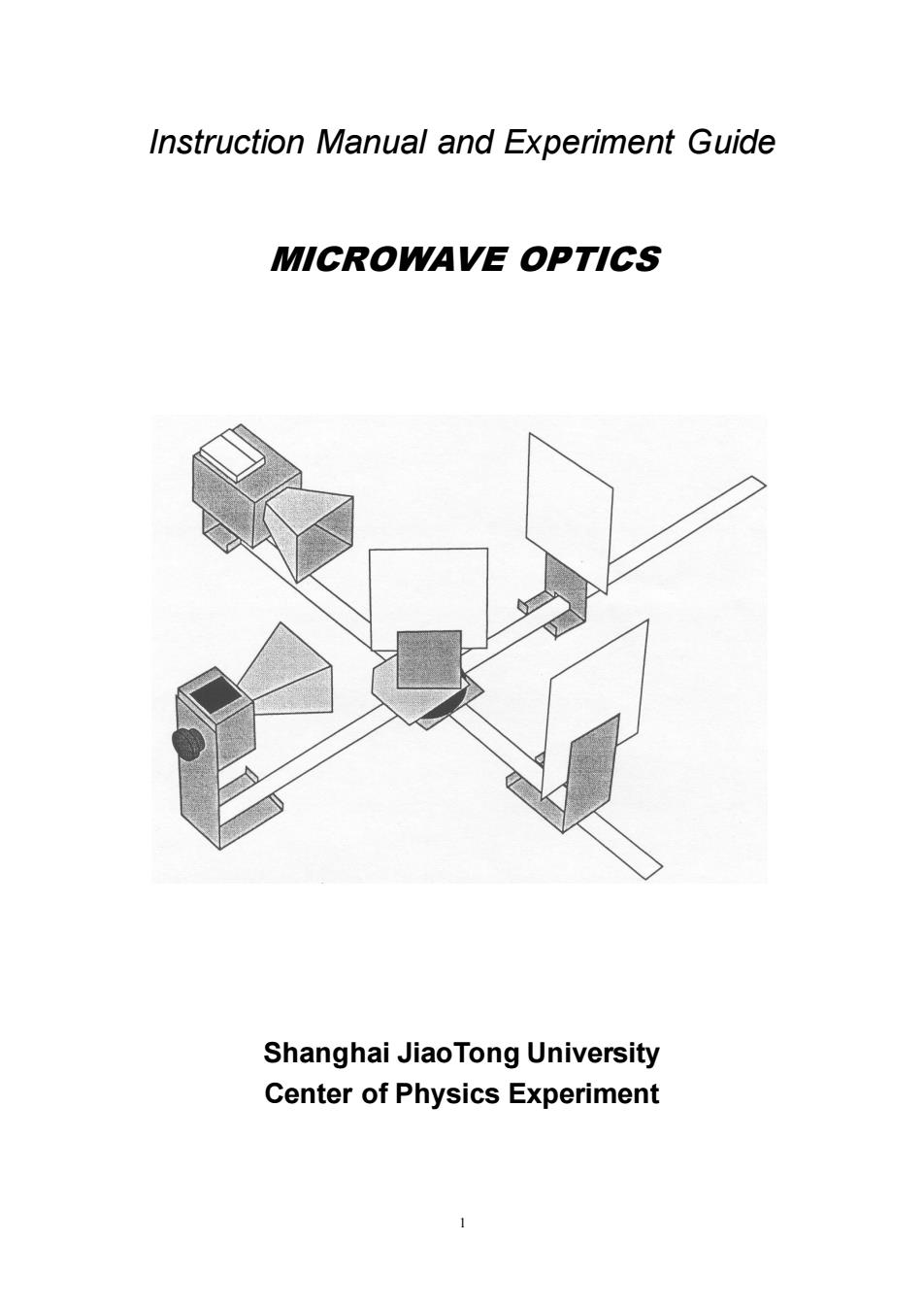
Instruction Manual and Experiment Guide MICROWAVE OPTICS Shanghai JiaoTong University Center of Physics Experiment
1 Instruction Manual and Experiment Guide MICROWAVE OPTICS Shanghai JiaoTong University Center of Physics Experiment
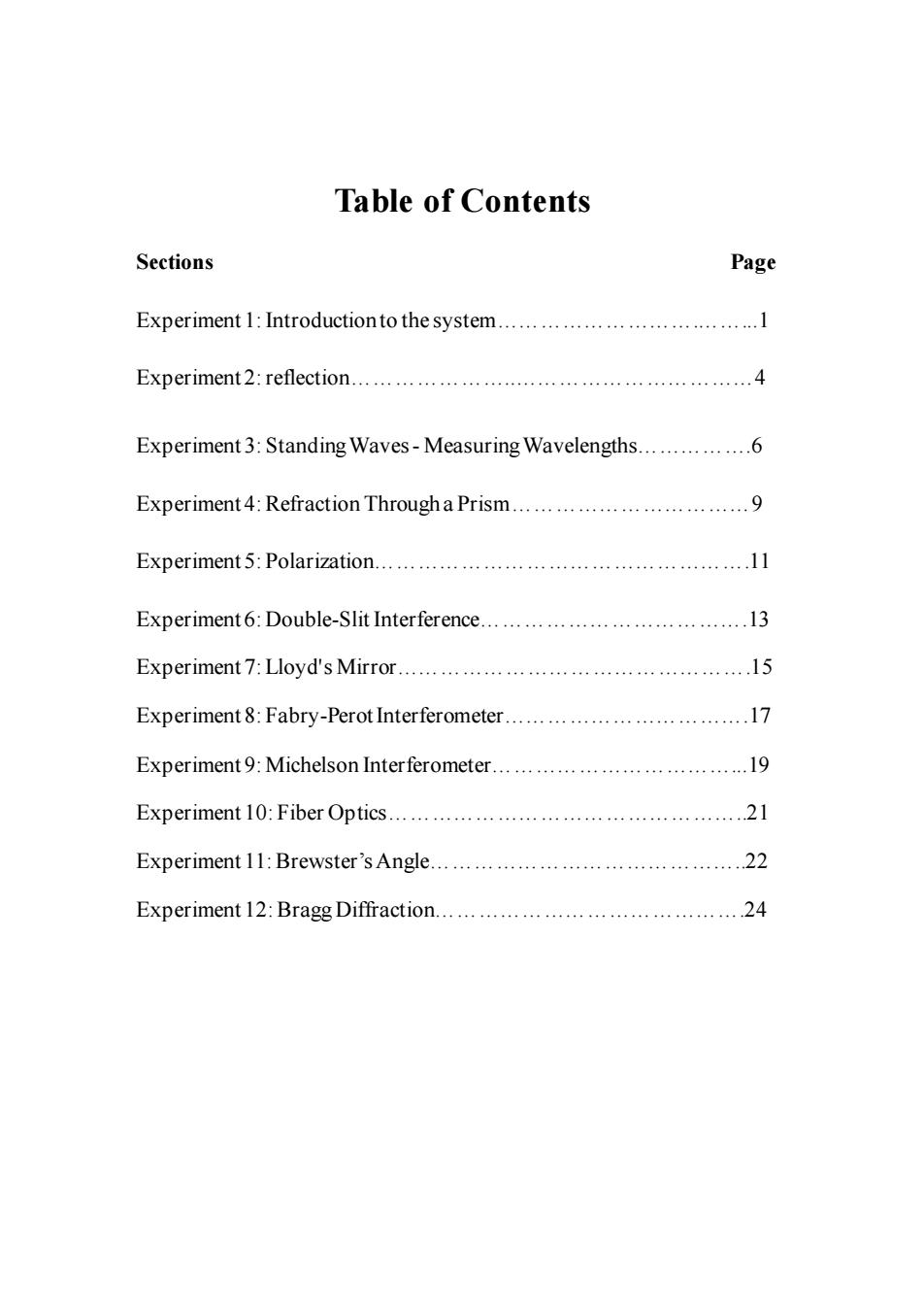
Table of Contents Sections Page Experiment 1:Introductionto the system............................... Experiment2:reflection................4 Experiment 3:Standing Waves-Measuring Wavelengths................6 Experiment 4:Refraction Through a Prism.................. …9 Experiment5:Polarization..........I Experiment6:Double-Slit Interference...............13 Experiment 7:Lloyd's Mirror....15 Experiment 8:Fabry-Perot Interferometer.......................... 17 Experiment 9:Michelson Interferometer....................... ..19 Experiment 10:Fiber Optics...................21 Experiment 11:Brewster's Angle........................ 22 Experiment 12:Bragg Diffraction..................................24
Table of Contents Sections Page Experiment 1: Introduction to the system……………………….……...1 Experiment 2: reflection…………………..……………………………4 Experiment 3: Standing Waves - Measuring Wavelengths…………….6 Experiment 4: Refraction Through a Prism……………………………9 Experiment 5: Polarization…………………………………………….11 Experiment 6: Double-Slit Interference……………………………….13 Experiment 7: Lloyd's Mirror………………………………………….15 Experiment 8: Fabry-Perot Interferometer…………………………….17 Experiment 9: Michelson Interferometer……………………………...19 Experiment 10: Fiber Optics…………………………………………..21 Experiment 11: Brewster’s Angle……………………………………..22 Experiment 12: Bragg Diffraction…………………………………….24
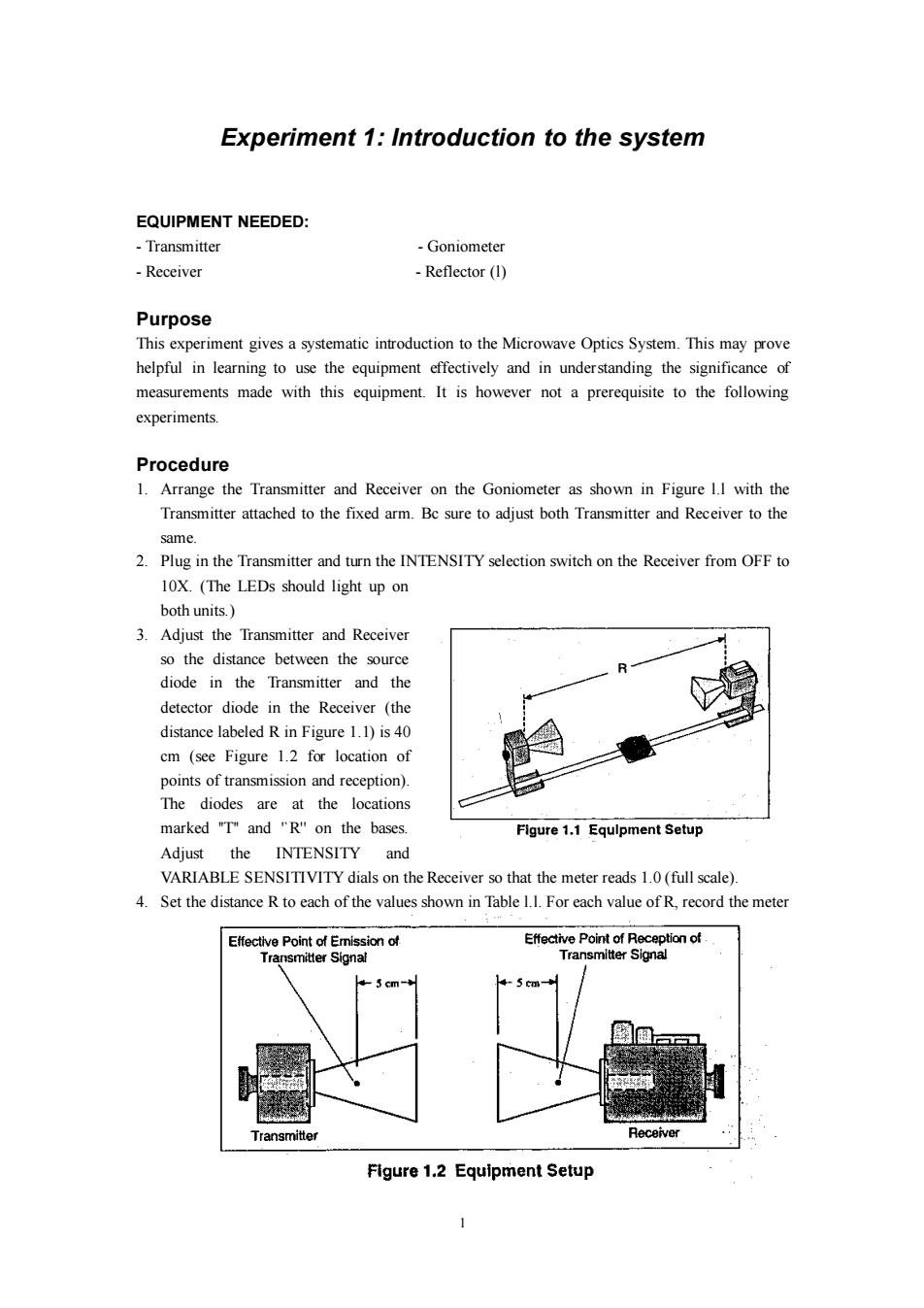
Experiment 1:Introduction to the system EQUIPMENT NEEDED: Transmitter -Goniometer -Receiver Reflector (1) Purpose This experiment gives a systematic introduction to the Microwave Optics System.This may prove helpful in learning to use the equipment effectively and in understanding the significance of measurements made with this equipment.It is however not a prerequisite to the following experiments. Procedure 1.Arrange the Transmitter and Receiver on the Goniometer as shown in Figure 1.I with the Transmitter attached to the fixed arm.Bc sure to adjust both Transmitter and Receiver to the same. 2.Plug in the Transmitter and turn the INTENSITY selection switch on the Receiver from OFF to 10X.(The LEDs should light up on both units. 3.Adjust the Transmitter and Receiver so the distance between the source diode in the Transmitter and the detector diode in the Receiver (the distance labeled R in Figure 1.1)is 40 cm (see Figure 1.2 for location of points of transmission and reception). The diodes are at the locations marked "T"and "R"on the bases. Figure 1.1 Equlpment Setup Adjust the INTENSITY and VARIABLE SENSITIVITY dials on the Receiver so that the meter reads 1.0(full scale). 4.Set the distance R to each of the values shown in Table 1.I.For each value of R,record the meter Effective Point of Emission of Effective Point of Reception of Transmitter Signal Transmitter Signal -5 cm- Transmitter Receiver Figure 1.2 Equipment Setup
1 Experiment 1: Introduction to the system EQUIPMENT NEEDED: - Transmitter - Goniometer - Receiver - Reflector (l) Purpose This experiment gives a systematic introduction to the Microwave Optics System. This may prove helpful in learning to use the equipment effectively and in understanding the significance of measurements made with this equipment. It is however not a prerequisite to the following experiments. Procedure 1. Arrange the Transmitter and Receiver on the Goniometer as shown in Figure l.l with the Transmitter attached to the fixed arm. Bc sure to adjust both Transmitter and Receiver to the same. 2. Plug in the Transmitter and turn the INTENSITY selection switch on the Receiver from OFF to 10X. (The LEDs should light up on both units.) 3. Adjust the Transmitter and Receiver so the distance between the source diode in the Transmitter and the detector diode in the Receiver (the distance labeled R in Figure 1.1) is 40 cm (see Figure 1.2 for location of points of transmission and reception). The diodes are at the locations marked ''T'' and '`R'' on the bases. Adjust the INTENSITY and VARIABLE SENSITIVITY dials on the Receiver so that the meter reads 1.0 (full scale). 4. Set the distance R to each of the values shown in Table l.l. For each value of R, record the meter
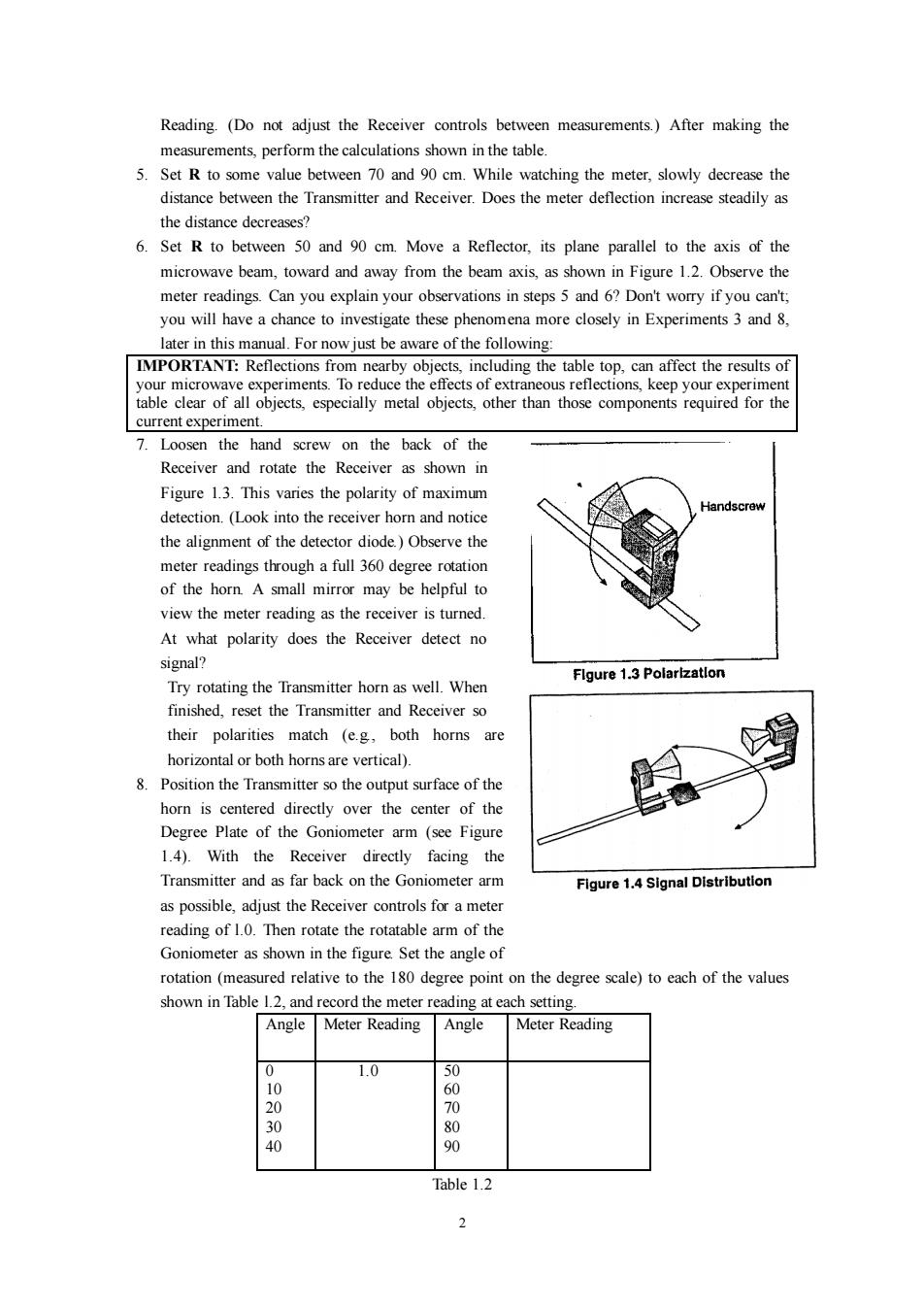
Reading.(Do not adjust the Receiver controls between measurements.)After making the measurements,perform the calculations shown in the table. 5.Set R to some value between 70 and 90 cm.While watching the meter,slowly decrease the distance between the Transmitter and Receiver.Does the meter deflection increase steadily as the distance decreases? 6.Set R to between 50 and 90 cm.Move a Reflector,its plane parallel to the axis of the microwave beam,toward and away from the beam axis,as shown in Figure 1.2.Observe the meter readings.Can you explain your observations in steps 5 and 6?Don't worry if you can't; you will have a chance to investigate these phenomena more closely in Experiments 3 and 8, later in this manual.For now just be aware of the following: IMPORTANT:Reflections from nearby objects,including the table top,can affect the results of your microwave experiments.To reduce the effects of extraneous reflections,keep your experiment table clear of all objects,especially metal objects,other than those components required for the current experiment. 7.Loosen the hand screw on the back of the Receiver and rotate the Receiver as shown in Figure 1.3.This varies the polarity of maximum Handscrew detection.(Look into the receiver horn and notice the alignment of the detector diode.)Observe the meter readings through a full 360 degree rotation of the horn.A small mirror may be helpful to view the meter reading as the receiver is turned. At what polarity does the Receiver detect no signal? Flgure 1.3 Polarlzatlon Try rotating the Transmitter horn as well.When finished,reset the Transmitter and Receiver so their polarities match (e.g,both horns are horizontal or both horns are vertical). 8.Position the Transmitter so the output surface of the horn is centered directly over the center of the Degree Plate of the Goniometer arm (see Figure 1.4).With the Receiver directly facing the Transmitter and as far back on the Goniometer arm Figure 1.4 Signal Distribution as possible,adjust the Receiver controls for a meter reading of 1.0.Then rotate the rotatable arm of the Goniometer as shown in the figure.Set the angle of rotation(measured relative to the 180 degree point on the degree scale)to each of the values shown in Table 1.2,and record the meter reading at each setting. Angle Meter Reading Angle Meter Reading 0 1.0 50 0 60 20 70 3 80 40 90 Table 1.2 2
2 Reading. (Do not adjust the Receiver controls between measurements.) After making the measurements, perform the calculations shown in the table. 5. Set R to some value between 70 and 90 cm. While watching the meter, slowly decrease the distance between the Transmitter and Receiver. Does the meter deflection increase steadily as the distance decreases? 6. Set R to between 50 and 90 cm. Move a Reflector, its plane parallel to the axis of the microwave beam, toward and away from the beam axis, as shown in Figure 1.2. Observe the meter readings. Can you explain your observations in steps 5 and 6? Don't worry if you can't; you will have a chance to investigate these phenomena more closely in Experiments 3 and 8, later in this manual. For now just be aware of the following: IMPORTANT: Reflections from nearby objects, including the table top, can affect the results of your microwave experiments. To reduce the effects of extraneous reflections, keep your experiment table clear of all objects, especially metal objects, other than those components required for the current experiment. 7. Loosen the hand screw on the back of the Receiver and rotate the Receiver as shown in Figure 1.3. This varies the polarity of maximum detection. (Look into the receiver horn and notice the alignment of the detector diode.) Observe the meter readings through a full 360 degree rotation of the horn. A small mirror may be helpful to view the meter reading as the receiver is turned. At what polarity does the Receiver detect no signal? Try rotating the Transmitter horn as well. When finished, reset the Transmitter and Receiver so their polarities match (e.g., both horns are horizontal or both horns are vertical). 8. Position the Transmitter so the output surface of the horn is centered directly over the center of the Degree Plate of the Goniometer arm (see Figure 1.4). With the Receiver directly facing the Transmitter and as far back on the Goniometer arm as possible, adjust the Receiver controls for a meter reading of l.0. Then rotate the rotatable arm of the Goniometer as shown in the figure. Set the angle of rotation (measured relative to the 180 degree point on the degree scale) to each of the values shown in Table l.2, and record the meter reading at each setting. Angle Meter Reading Angle Meter Reading 0 10 20 30 40 1.0 50 60 70 80 90 Table 1.2
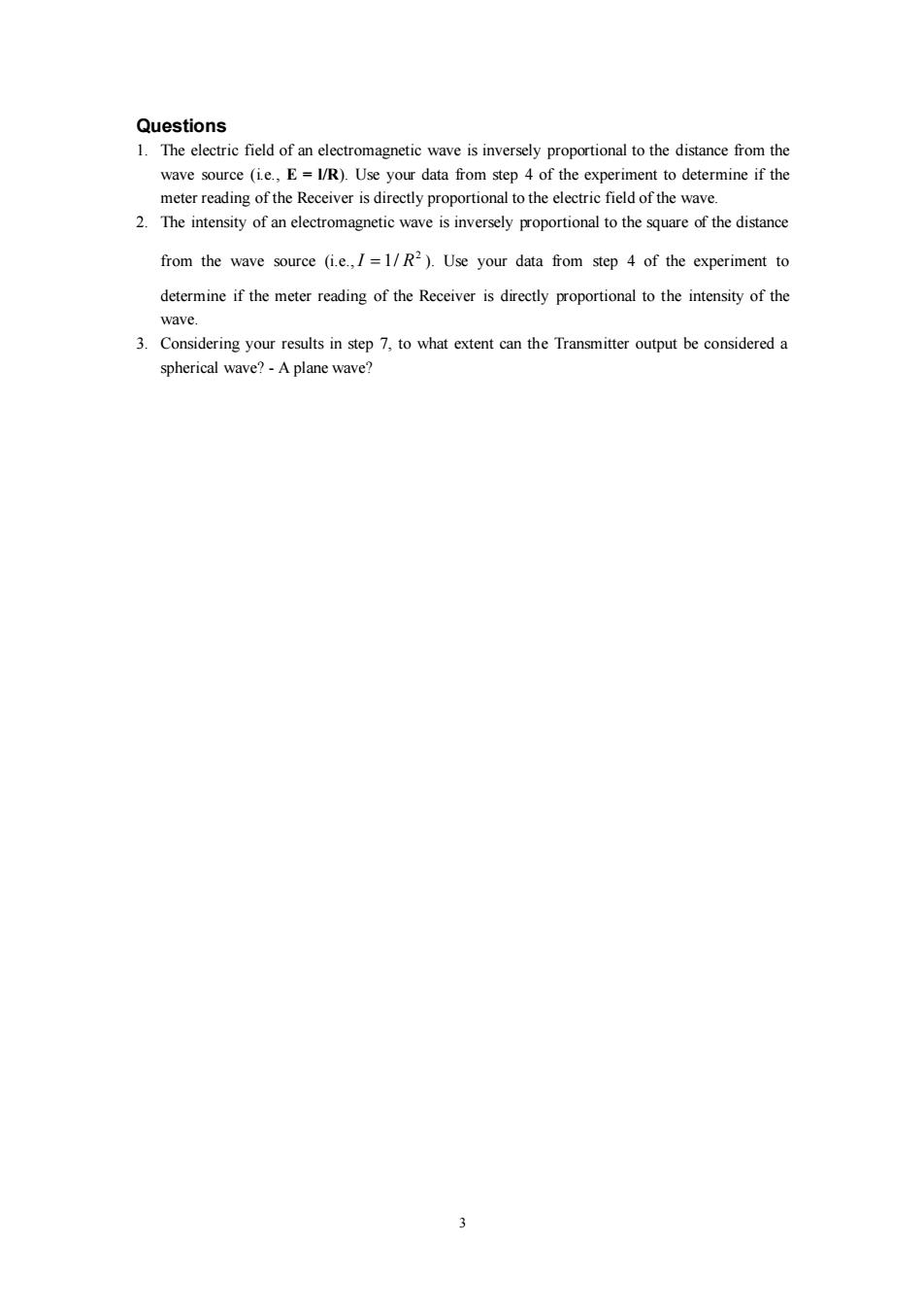
Questions 1.The electric field of an electromagnetic wave is inversely proportional to the distance from the wave source (ie.,E =I/R).Use your data from step 4 of the experiment to determine if the meter reading of the Receiver is directly proportional to the electric field of the wave. 2.The intensity of an electromagnetic wave is inversely proportional to the square of the distance from the wave source (i.e.,I=1/R2).Use your data from step 4 of the experiment to determine if the meter reading of the Receiver is directly proportional to the intensity of the wave. 3.Considering your results in step 7,to what extent can the Transmitter output be considered a spherical wave?-A plane wave?
3 Questions 1. The electric field of an electromagnetic wave is inversely proportional to the distance from the wave source (i.e., E = l/R). Use your data from step 4 of the experiment to determine if the meter reading of the Receiver is directly proportional to the electric field of the wave. 2. The intensity of an electromagnetic wave is inversely proportional to the square of the distance from the wave source (i.e., 2 I = 1/ R ). Use your data from step 4 of the experiment to determine if the meter reading of the Receiver is directly proportional to the intensity of the wave. 3. Considering your results in step 7, to what extent can the Transmitter output be considered a spherical wave? - A plane wave?

Experiment 2:reflection EQUIPMENT NEEDED: -Transmitter -Goniometer -Receiver -Metal Reflector -Rotating Component Holder Procedure 1.Arrange the equipment as shown in figure 2.1 with the Transmitter attached to the fixed arm of the Goniometer.Be sure to adjust the Transmitter and Receiver to the same polarity, the horns should have the same orientation as shown. 2.Plug in the Transmitter and turn the Receiver INTENSITY selections switch to 30X. 3.The angle between the incident wave from the Transmitter and a line normal to the plane of Figure 2.1 Equipment Setup the Reflector is called the Angle of incidence (see Figure 2.2).Adjust the Rotating Component Reflector holder so that the Angle of Incidence. 4.Without moving the Transmitter or the Reflector, rotate the movable axis of the Goniometer until Angle of Incidence the meter reading is a maximum.The angle Angle of between the axis of the Receiver horn and a line Reflection normal to the plane of the Reflector is called the Figure 2.2 Angles of Incidence and Reflection Angle of Reflection. 5.Measure and record the angle of reflection for each of the angles of incidence shown in Table 2.1. Table 2.1 Angle of Angle of Incidence NOTE:At various angle settings the Reflection Receiver will detect both the reflected wave 20 30 and the wave coming directly from the 40 Transmitter,thus giving misleading results. 50 Determine the angles for which this is true and 6 70 mark the data collected at these angles with an 80 asterisk " 90
4 Experiment 2: reflection EQUIPMENT NEEDED: -Transmitter -Goniometer -Receiver -Metal Reflector -Rotating Component Holder Procedure 1. Arrange the equipment as shown in figure 2.1 with the Transmitter attached to the fixed arm of the Goniometer. Be sure to adjust the Transmitter and Receiver to the same polarity, the horns should have the same orientation as shown. 2. Plug in the Transmitter and turn the Receiver INTENSITY selections switch to 30X. 3. The angle between the incident wave from the Transmitter and a line normal to the plane of the Reflector is called the Angle of incidence (see Figure 2.2). Adjust the Rotating Component holder so that the Angle of Incidence. 4. Without moving the Transmitter or the Reflector, rotate the movable axis of the Goniometer until the meter reading is a maximum. The angle between the axis of the Receiver horn and a line normal to the plane of the Reflector is called the Angle of Reflection. 5. Measure and record the angle of reflection for each of the angles of incidence shown in Table 2.1. Table 2.1 Angle of Incidence Angle of Reflection 20 30 40 50 60 70 80 90 NOTE: At various angle settings the Receiver will detect both the reflected wave and the wave coming directly from the Transmitter, thus giving misleading results. Determine the angles for which this is true and mark the data collected at these angles with an asterisk "*
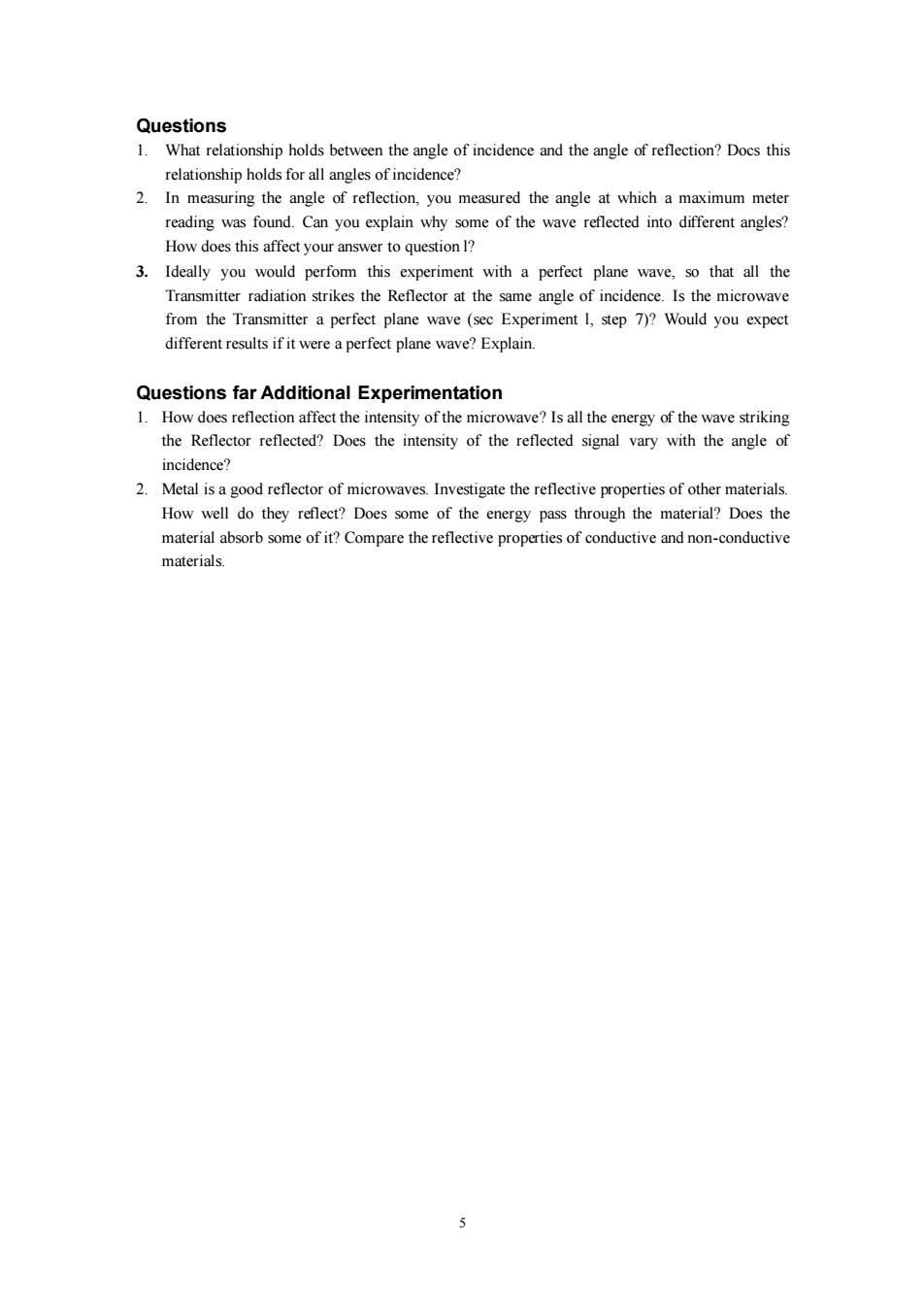
Questions 1.What relationship holds between the angle of incidence and the angle of reflection?Docs this relationship holds for all angles of incidence? 2.In measuring the angle of reflection,you measured the angle at which a maximum meter reading was found.Can you explain why some of the wave reflected into different angles? How does this affect your answer to question 1? 3.Ideally you would perform this experiment with a perfect plane wave,so that all the Transmitter radiation strikes the Reflector at the same angle of incidence.Is the microwave from the Transmitter a perfect plane wave(sec Experiment 1,step 7)?Would you expect different results if it were a perfect plane wave?Explain. Questions far Additional Experimentation 1.How does reflection affect the intensity of the microwave?Is all the energy of the wave striking the Reflector reflected?Does the intensity of the reflected signal vary with the angle of incidence? 2.Metal is a good reflector of microwaves.Investigate the reflective properties of other materials. How well do they reflect?Does some of the energy pass through the material?Does the material absorb some of it?Compare the reflective properties of conductive and non-conductive materials
5 Questions 1. What relationship holds between the angle of incidence and the angle of reflection? Docs this relationship holds for all angles of incidence? 2. In measuring the angle of reflection, you measured the angle at which a maximum meter reading was found. Can you explain why some of the wave reflected into different angles? How does this affect your answer to question l? 3. Ideally you would perform this experiment with a perfect plane wave, so that all the Transmitter radiation strikes the Reflector at the same angle of incidence. Is the microwave from the Transmitter a perfect plane wave (sec Experiment l, step 7)? Would you expect different results if it were a perfect plane wave? Explain. Questions far Additional Experimentation 1. How does reflection affect the intensity of the microwave? Is all the energy of the wave striking the Reflector reflected? Does the intensity of the reflected signal vary with the angle of incidence? 2. Metal is a good reflector of microwaves. Investigate the reflective properties of other materials. How well do they reflect? Does some of the energy pass through the material? Does the material absorb some of it? Compare the reflective properties of conductive and non-conductive materials
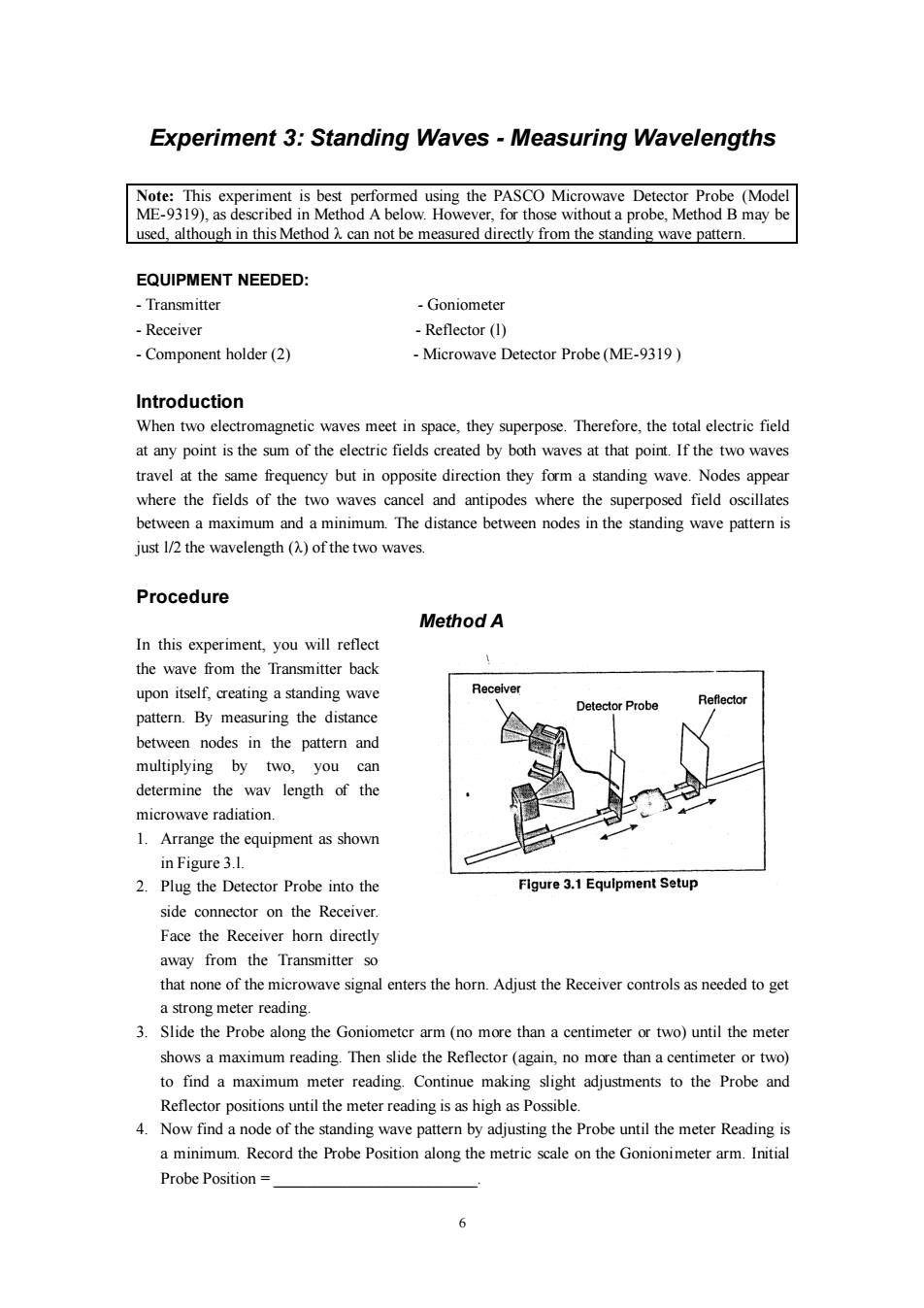
Experiment 3:Standing Waves -Measuring Wavelengths Note:This experiment is best performed using the PASCO Microwave Detector Probe (Model ME-9319),as described in Method A below.However,for those without a probe,Method B may be used,although in this Method A can not be measured directly from the standing wave pattern. EQUIPMENT NEEDED: -Transmitter -Goniometer -Receiver Reflector(1) Component holder(2) Microwave Detector Probe(ME-9319) Introduction When two electromagnetic waves meet in space,they superpose.Therefore,the total electric field at any point is the sum of the electric fields created by both waves at that point.If the two waves travel at the same frequency but in opposite direction they form a standing wave.Nodes appear where the fields of the two waves cancel and antipodes where the superposed field oscillates between a maximum and a minimum.The distance between nodes in the standing wave pattern is just 1/2 the wavelength (A)of the two waves. Procedure Method A In this experiment,you will reflect the wave from the Transmitter back upon itself,creating a standing wave Receiver Detector Probe Reflector pattern.By measuring the distance between nodes in the pattern and multiplying by two,you can determine the wav length of the microwave radiation. 1.Arrange the equipment as shown in Figure 3.1. 2.Plug the Detector Probe into the Figure 3.1 Equlpment Setup side connector on the Receiver. Face the Receiver horn directly away from the Transmitter so that none of the microwave signal enters the horn.Adjust the Receiver controls as needed to get a strong meter reading. 3.Slide the Probe along the Goniometcr arm(no more than a centimeter or two)until the meter shows a maximum reading.Then slide the Reflector(again,no more than a centimeter or two) to find a maximum meter reading.Continue making slight adjustments to the Probe and Reflector positions until the meter reading is as high as Possible. 4.Now find a node of the standing wave pattern by adjusting the Probe until the meter Reading is a minimum.Record the Probe Position along the metric scale on the Gonionimeter arm.Initial Probe Position 6
6 Experiment 3: Standing Waves - Measuring Wavelengths Note: This experiment is best performed using the PASCO Microwave Detector Probe (Model ME-9319), as described in Method A below. However, for those without a probe, Method B may be used, although in this Method λ can not be measured directly from the standing wave pattern. EQUIPMENT NEEDED: - Transmitter - Goniometer - Receiver - Reflector (l) - Component holder (2) - Microwave Detector Probe (ME-9319 ) Introduction When two electromagnetic waves meet in space, they superpose. Therefore, the total electric field at any point is the sum of the electric fields created by both waves at that point. If the two waves travel at the same frequency but in opposite direction they form a standing wave. Nodes appear where the fields of the two waves cancel and antipodes where the superposed field oscillates between a maximum and a minimum. The distance between nodes in the standing wave pattern is just l/2 the wavelength (λ) of the two waves. Procedure Method A In this experiment, you will reflect the wave from the Transmitter back upon itself, creating a standing wave pattern. By measuring the distance between nodes in the pattern and multiplying by two, you can determine the wav length of the microwave radiation. 1. Arrange the equipment as shown in Figure 3.l. 2. Plug the Detector Probe into the side connector on the Receiver. Face the Receiver horn directly away from the Transmitter so that none of the microwave signal enters the horn. Adjust the Receiver controls as needed to get a strong meter reading. 3. Slide the Probe along the Goniometcr arm (no more than a centimeter or two) until the meter shows a maximum reading. Then slide the Reflector (again, no more than a centimeter or two) to find a maximum meter reading. Continue making slight adjustments to the Probe and Reflector positions until the meter reading is as high as Possible. 4. Now find a node of the standing wave pattern by adjusting the Probe until the meter Reading is a minimum. Record the Probe Position along the metric scale on the Gonionimeter arm. Initial Probe Position = _________________________
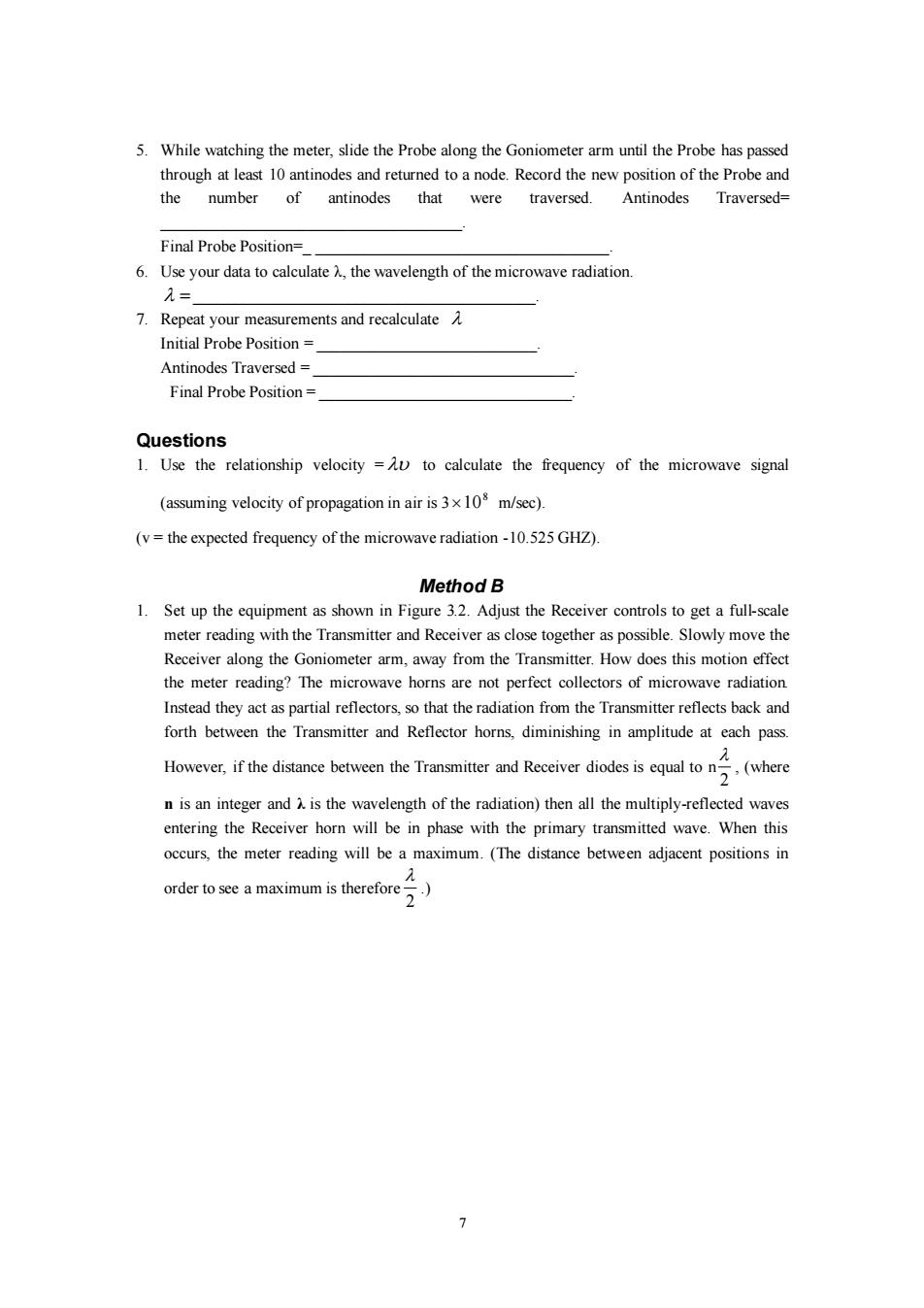
5.While watching the meter,slide the Probe along the Goniometer arm until the Probe has passed through at least 10 antinodes and returned to a node.Record the new position of the Probe and the number of antinodes that were traversed. Antinodes Traversed= Final Probe Position= 6.Use your data to calculate A,the wavelength of the microwave radiation. 九= 7.Repeat your measurements and recalculateA Initial Probe Position Antinodes Traversed Final Probe Position= Questions 1.Use the relationship velocity =u to calculate the frequency of the microwave signal (assuming velocity of propagation in air is 3x108 m/sec). (v=the expected frequency of the microwave radiation-10.525 GHZ). Method B 1.Set up the equipment as shown in Figure 3.2.Adjust the Receiver controls to get a full-scale meter reading with the Transmitter and Receiver as close together as possible.Slowly move the Receiver along the Goniometer arm,away from the Transmitter.How does this motion effect the meter reading?The microwave horns are not perfect collectors of microwave radiation Instead they act as partial reflectors,so that the radiation from the Transmitter reflects back and forth between the Transmitter and Reflector horns,diminishing in amplitude at each pass. λ However,if the distance beteen the Trnsmiter and Receiver diodes is quto(where n is an integer and A is the wavelength of the radiation)then all the multiply-reflected waves entering the Receiver horn will be in phase with the primary transmitted wave.When this occurs,the meter reading will be a maximum.(The distance between adjacent positions in order to see a maximum is therefore-.) 2 >
7 5. While watching the meter, slide the Probe along the Goniometer arm until the Probe has passed through at least 10 antinodes and returned to a node. Record the new position of the Probe and the number of antinodes that were traversed. Antinodes Traversed= _____________________________________. Final Probe Position=_ ____________________________________. 6. Use your data to calculate λ, the wavelength of the microwave radiation. =__________________________________________. 7. Repeat your measurements and recalculate Initial Probe Position = ___________________________. Antinodes Traversed = ________________________________. Final Probe Position = _______________________________. Questions 1. Use the relationship velocity = to calculate the frequency of the microwave signal (assuming velocity of propagation in air is 3 8 10 m/sec). (v = the expected frequency of the microwave radiation -10.525 GHZ). Method B 1. Set up the equipment as shown in Figure 3.2. Adjust the Receiver controls to get a full-scale meter reading with the Transmitter and Receiver as close together as possible. Slowly move the Receiver along the Goniometer arm, away from the Transmitter. How does this motion effect the meter reading? The microwave horns are not perfect collectors of microwave radiation. Instead they act as partial reflectors, so that the radiation from the Transmitter reflects back and forth between the Transmitter and Reflector horns, diminishing in amplitude at each pass. However, if the distance between the Transmitter and Receiver diodes is equal to n 2 , (where n is an integer and λ is the wavelength of the radiation) then all the multiply-reflected waves entering the Receiver horn will be in phase with the primary transmitted wave. When this occurs, the meter reading will be a maximum. (The distance between adjacent positions in order to see a maximum is therefore 2 .)
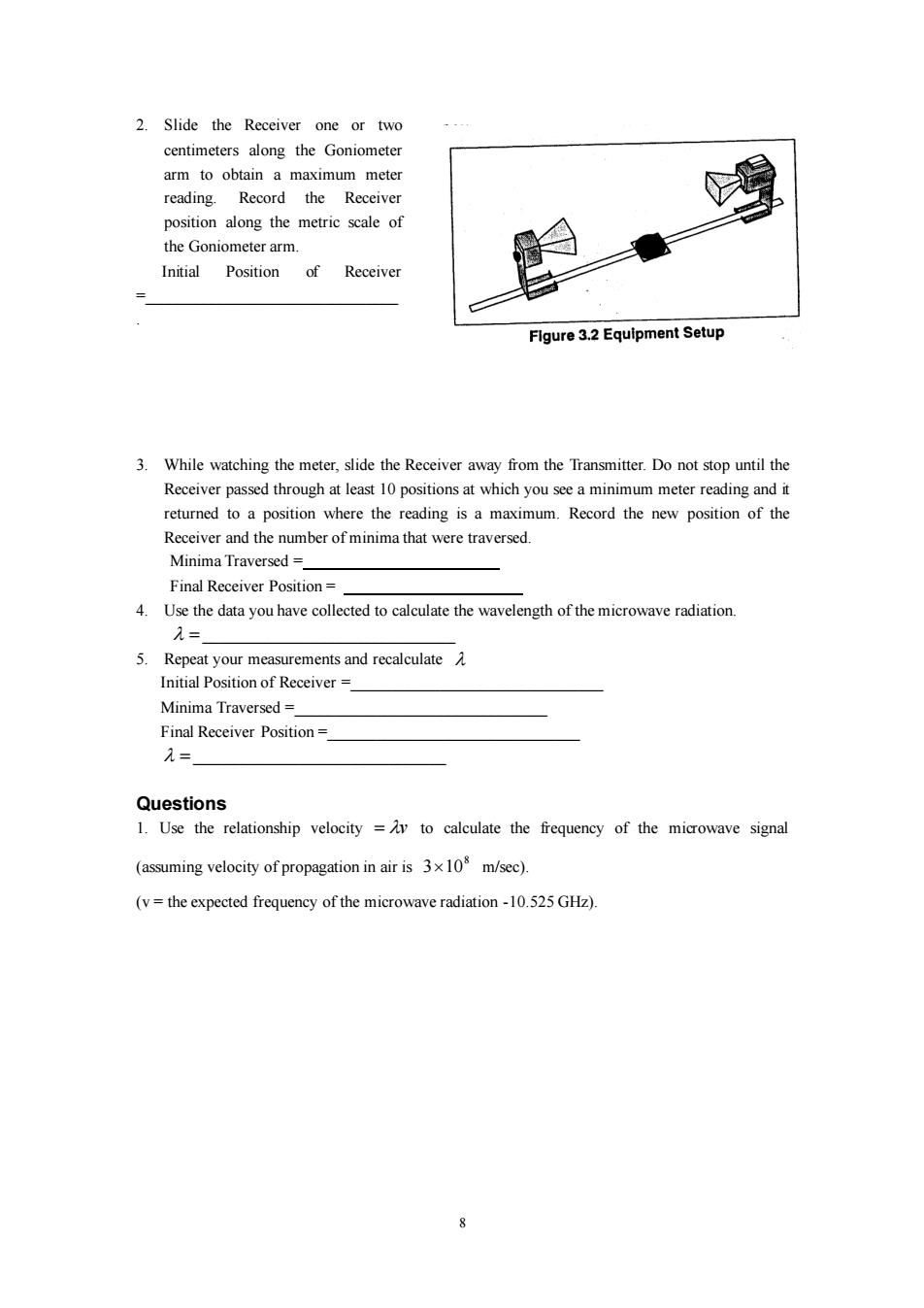
2.Slide the Receiver one or two centimeters along the Goniometer arm to obtain a maximum meter reading.Record the Receiver position along the metric scale of the Goniometer arm Initial Position of Receiver Figure 3.2 Equipment Setup 3.While watching the meter,slide the Receiver away from the Transmitter.Do not stop until the Receiver passed through at least 10 positions at which you see a minimum meter reading and it returned to a position where the reading is a maximum.Record the new position of the Receiver and the number of minima that were traversed. Minima Traversed Final Receiver Position= 4.Use the data you have collected to calculate the wavelength of the microwave radiation. λ= 5.Repeat your measurements and recalculate Initial Position of Receiver Minima Traversed Final Receiver Position= 九= Questions 1.Use the relationship velocity =y to calculate the frequency of the microwave signal (assuming velocity of propagation in air is 3x10 m/sec). (v=the expected frequency of the microwave radiation-10.525 GHz)
8 2. Slide the Receiver one or two centimeters along the Goniometer arm to obtain a maximum meter reading. Record the Receiver position along the metric scale of the Goniometer arm. Initial Position of Receiver =_______________________________ . 3. While watching the meter, slide the Receiver away from the Transmitter. Do not stop until the Receiver passed through at least 10 positions at which you see a minimum meter reading and it returned to a position where the reading is a maximum. Record the new position of the Receiver and the number of minima that were traversed. Minima Traversed = Final Receiver Position = 4. Use the data you have collected to calculate the wavelength of the microwave radiation. =_______________________________ 5. Repeat your measurements and recalculate Initial Position of Receiver =_______________________________ Minima Traversed =_______________________________ Final Receiver Position =_______________________________ =_______________________________ Questions 1. Use the relationship velocity = v to calculate the frequency of the microwave signal (assuming velocity of propagation in air is 8 310 m/sec). (v = the expected frequency of the microwave radiation -10.525 GHz)